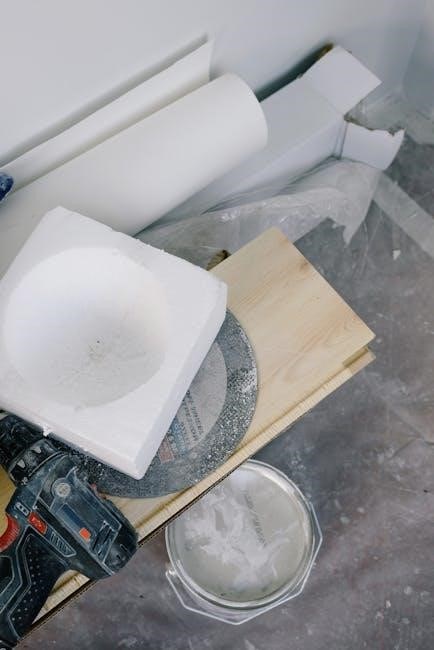drill & tap guide
Drill and tap guide provides essential information on drill bits and taps, helping users determine correct sizes and threads for various applications, utilizing charts and formulas for accuracy always online.
Understanding the Basics of Tap and Drill
To understand the basics of tap and drill, it is essential to know the relationship between drill bits and taps. The drill bit is used to create a hole, and the tap is used to create threads in the hole. The size of the drill bit and tap depends on the type of thread being created. For example, metric threads and imperial threads have different drill bit and tap sizes. The tap and drill guide provides a chart that lists the different drill bit and tap sizes for various thread types. This chart is crucial in ensuring that the correct drill bit and tap are used for a specific threading application. By understanding the basics of tap and drill, users can accurately determine the correct drill bit and tap sizes for their specific needs, utilizing the guide to achieve professional results and avoid errors.

Drill and Tap Chart
Drill and tap charts provide essential information on drill sizes and tap sizes for various threading applications always online in a table format for easy reference and use.
How to Use a Drill and Tap Chart
To use a drill and tap chart, first identify the type of thread and its size, then locate the corresponding drill size on the chart, which provides the closest drill size for a specific thread. The chart typically includes information on metric and imperial units, as well as different types of threads, such as ISO, DIN, UTS, UNC, UNS, and UNF bolts. By referring to the chart, users can determine the correct drill bit size to use for a particular threading application, ensuring accuracy and efficiency. The chart is usually available in a table format, making it easy to read and understand, and it can be used for a variety of applications, including drilling and tapping operations. Additionally, the chart can be used to determine the correct tap size for a given hole size, and it provides a convenient reference for users to quickly look up the required drill and tap sizes.
Calculating Tapping Drill Size
Calculating tapping drill size involves subtracting pitch from thread diameter for metric threads using formulas online always.
Formula for Metric and Imperial Units
The formula for calculating tapping drill size is a fundamental concept in the drill and tap guide, applicable to both metric and imperial units. This formula involves subtracting the pitch from the diameter of the thread, which provides the correct drill size for tapping. The formula works for all 60-degree threads, including ISO, DIN, UTS, UNC, UNS, and UNF bolts. By using this formula, users can determine the correct drill size for their specific threading needs, ensuring accurate and precise results. The formula is widely used in various industries, including manufacturing and engineering, where precision and accuracy are crucial. With the formula, users can easily calculate the tapping drill size, making it an essential tool in the drill and tap guide. The formula is also available in online resources, providing easy access to users.

Tap Drill Chart
Tap drill charts provide drill sizes for various threads, available in mm and inches, helping users determine correct drill bits for tapping, using online resources always for accuracy and convenience.
Available as a Printable PDF
The tap drill chart is available as a printable PDF, making it easy to access and use offline, this feature is particularly useful for users who need to reference the chart frequently.
The PDF version can be downloaded and printed, allowing users to keep a physical copy in their workshop or office, reducing the need to constantly search for the information online.
This convenience factor is a major advantage, as it saves time and increases productivity, the printable PDF is also a useful resource for users who prefer to work with physical documents.
Additionally, the PDF version can be easily shared with others, making it a useful tool for collaboration and communication, the tap drill chart PDF is a valuable resource for anyone working with drills and taps.
The PDF format is widely compatible, making it accessible on a variety of devices, from computers to mobile phones, the tap drill chart PDF is a handy reference guide that can be used in a variety of settings.

Producing Thread Holes
Drilling and tapping process creates thread holes with precision and accuracy always using correct drill bits and taps sizes.
Drilling and Tapping Process
The drilling and tapping process involves several steps to create thread holes with precision and accuracy;
First, a hole is drilled using a drill bit, then a tap is used to create the threads.
The tap is turned clockwise to cut the threads, and the process is repeated for each hole.
Using the correct drill bit and tap size is crucial to ensure a proper fit and to avoid damaging the material.
The drilling and tapping process can be used for various materials, including metal, wood, and plastic.
It is a common method used in manufacturing, construction, and other industries where threaded holes are required.
The process can be done manually or using machine tools, depending on the complexity and quantity of the holes needed.
Proper technique and safety precautions are essential to avoid accidents and ensure a successful outcome.
The drilling and tapping process is a fundamental skill in many trades and industries, and it is an essential part of the drill and tap guide.

Removing a Broken Tap
Using lubricating oil and a tool to hit the bevel helps remove a broken tap from material safely always online using correct techniques.
Steps to Extract a Stuck Tap
To extract a stuck tap, several methods can be employed, including the use of lubricating oil to loosen the tap, and applying gentle force in the opposite direction of the tap.
A harder drill bit can also be used to carefully drill into the broken tap, allowing for its removal, and a tap extractor is a specialized tool designed for this purpose, providing a safe and efficient means of extracting stuck taps from materials, and can be used in conjunction with other methods for optimal results, always following proper safety protocols and procedures to avoid further damage or injury, and ensuring the extraction process is done with care and attention to detail, using the correct techniques and tools for the specific situation, and taking necessary precautions to prevent accidents and ensure a successful extraction.

























